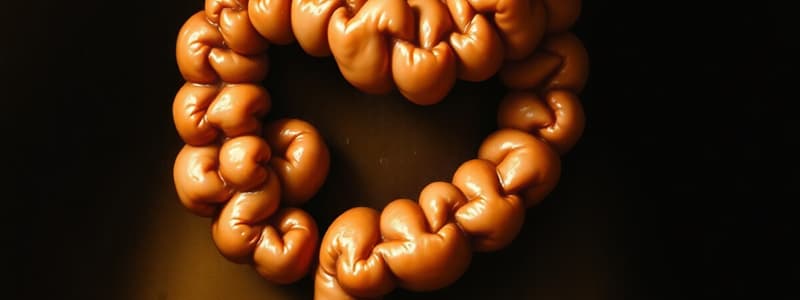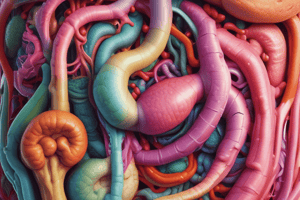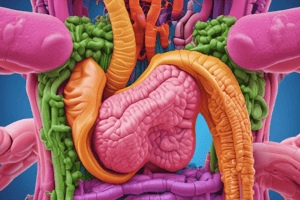Podcast
Questions and Answers
What is the primary function of sodium bicarbonate in the small intestine?
What is the primary function of sodium bicarbonate in the small intestine?
- To neutralize acidic chyme (correct)
- To promote bacterial growth
- To enhance the absorption of nutrients
- To digest starches
Which sequence correctly lists the parts of the small intestine?
Which sequence correctly lists the parts of the small intestine?
- Duodenum, ileum, jejunum
- Duodenum, jejunum, ileum (correct)
- Jejunum, duodenum, ileum
- Ileum, jejunum, duodenum
What movement is responsible for pushing contents along the gastrointestinal tract?
What movement is responsible for pushing contents along the gastrointestinal tract?
- Digestion
- Segmentation
- Peristalsis (correct)
- Absorption
What type of muscles are primarily responsible for peristalsis in the small intestine?
What type of muscles are primarily responsible for peristalsis in the small intestine?
Which of the following statements about the small intestine is true?
Which of the following statements about the small intestine is true?
What is the primary site for the absorption of most nutrients in the intestine?
What is the primary site for the absorption of most nutrients in the intestine?
Which type of absorption allows molecules to pass through the membrane freely without energy expenditure?
Which type of absorption allows molecules to pass through the membrane freely without energy expenditure?
What role do microvilli play in nutrient absorption?
What role do microvilli play in nutrient absorption?
What does facilitated diffusion require for the transport of molecules?
What does facilitated diffusion require for the transport of molecules?
Which of the following substances primarily uses simple/passive diffusion for absorption?
Which of the following substances primarily uses simple/passive diffusion for absorption?
What is the primary function of salivary amylase in the digestive process?
What is the primary function of salivary amylase in the digestive process?
Which of the following components is NOT found in saliva?
Which of the following components is NOT found in saliva?
What role does the gastroesophageal sphincter play in digestion?
What role does the gastroesophageal sphincter play in digestion?
What is the primary component of gastric juice that helps denature proteins?
What is the primary component of gastric juice that helps denature proteins?
What process does chewing represent in the digestive system?
What process does chewing represent in the digestive system?
Which type of digestion primarily occurs in the stomach?
Which type of digestion primarily occurs in the stomach?
Which of the following best describes the function of mucus in saliva?
Which of the following best describes the function of mucus in saliva?
Which enzyme in gastric juice is responsible for acting on proteins?
Which enzyme in gastric juice is responsible for acting on proteins?
What is the primary function of fructo-oligosaccharides and inulin in the digestive system?
What is the primary function of fructo-oligosaccharides and inulin in the digestive system?
Which of the following correctly describes synbiotics?
Which of the following correctly describes synbiotics?
What is the main function of the lymphatic system?
What is the main function of the lymphatic system?
What primary role do bacteria in the large intestine serve regarding undigested food particles?
What primary role do bacteria in the large intestine serve regarding undigested food particles?
How does the hepatic portal system function in nutrient absorption?
How does the hepatic portal system function in nutrient absorption?
Which vitamins are produced by bacteria in the large intestine?
Which vitamins are produced by bacteria in the large intestine?
What role does the liver play as a major metabolic organ?
What role does the liver play as a major metabolic organ?
What is the effect of an imbalance in gut flora?
What is the effect of an imbalance in gut flora?
Which statement best characterizes homeostasis?
Which statement best characterizes homeostasis?
What is a defining characteristic of probiotics?
What is a defining characteristic of probiotics?
Which of the following sources is rich in inulin?
Which of the following sources is rich in inulin?
What is the primary responsibility of the vascular system?
What is the primary responsibility of the vascular system?
What type of compounds are prebiotics primarily composed of?
What type of compounds are prebiotics primarily composed of?
What critical factor allows bacteria to survive in the stomach when taking probiotics?
What critical factor allows bacteria to survive in the stomach when taking probiotics?
What is the primary function of negative feedback in blood glucose regulation?
What is the primary function of negative feedback in blood glucose regulation?
What components are included in the central nervous system (CNS)?
What components are included in the central nervous system (CNS)?
Which hormone inhibits gastric motility when pH is below 4.5?
Which hormone inhibits gastric motility when pH is below 4.5?
What triggers the secretion of cholecystokinin (CCK)?
What triggers the secretion of cholecystokinin (CCK)?
What does gastric-inhibitory peptide (GIP) stimulate in response to glucose?
What does gastric-inhibitory peptide (GIP) stimulate in response to glucose?
What happens to gastrin secretion when dietary protein increases?
What happens to gastrin secretion when dietary protein increases?
What effect does secretin have when pH in the duodenum is below 4.5?
What effect does secretin have when pH in the duodenum is below 4.5?
Which hormone is responsible for stimulating bicarbonate secretion from the pancreas?
Which hormone is responsible for stimulating bicarbonate secretion from the pancreas?
What condition inhibits GIP secretion?
What condition inhibits GIP secretion?
How does the enteric nervous system function within the peripheral nervous system?
How does the enteric nervous system function within the peripheral nervous system?
What is one major outcome of gastrin release from the G cells in the stomach?
What is one major outcome of gastrin release from the G cells in the stomach?
Which factor is most likely to inhibit the secretion of secretin?
Which factor is most likely to inhibit the secretion of secretin?
Which hormone directly influences the release of bile from the gallbladder?
Which hormone directly influences the release of bile from the gallbladder?
What condition creates an environment that inhibits gastric motility as indicated by secretin?
What condition creates an environment that inhibits gastric motility as indicated by secretin?
Flashcards
What are the three parts of the small intestine?
What are the three parts of the small intestine?
The small intestine has three parts: the duodenum, jejunum, and ileum.
What is peristalsis?
What is peristalsis?
The process of successive waves of involuntary muscular contractions that move food through the digestive tract.
How do circular and longitudinal muscles contribute to digestion?
How do circular and longitudinal muscles contribute to digestion?
The small intestine has two layers of muscle: circular and longitudinal. These muscles work together to create peristalsis and segmentation, which helps move food through the digestive tract.
What is the small intestine's role in digestion?
What is the small intestine's role in digestion?
Signup and view all the flashcards
Why is sodium bicarbonate released into the small intestine?
Why is sodium bicarbonate released into the small intestine?
Signup and view all the flashcards
Microvilli
Microvilli
Signup and view all the flashcards
Simple Diffusion
Simple Diffusion
Signup and view all the flashcards
Facilitated Diffusion
Facilitated Diffusion
Signup and view all the flashcards
Absorption
Absorption
Signup and view all the flashcards
How does absorption happen in the small intestines?
How does absorption happen in the small intestines?
Signup and view all the flashcards
Cephalic Phase
Cephalic Phase
Signup and view all the flashcards
Mechanical Digestion: Chewing
Mechanical Digestion: Chewing
Signup and view all the flashcards
Chemical Digestion
Chemical Digestion
Signup and view all the flashcards
Salivary Glands
Salivary Glands
Signup and view all the flashcards
Salivary Amylase
Salivary Amylase
Signup and view all the flashcards
Gastroesophageal Sphincter
Gastroesophageal Sphincter
Signup and view all the flashcards
Mechanical Digestion in the Stomach
Mechanical Digestion in the Stomach
Signup and view all the flashcards
Gastric Juice
Gastric Juice
Signup and view all the flashcards
Bacterial Fermentation in Large Intestine
Bacterial Fermentation in Large Intestine
Signup and view all the flashcards
Waste Storage & Absorption in Large Intestine
Waste Storage & Absorption in Large Intestine
Signup and view all the flashcards
Vitamin Production by Gut Bacteria
Vitamin Production by Gut Bacteria
Signup and view all the flashcards
Gut Flora
Gut Flora
Signup and view all the flashcards
Gut Flora Imbalance
Gut Flora Imbalance
Signup and view all the flashcards
Probiotics
Probiotics
Signup and view all the flashcards
Benefits of Probiotics
Benefits of Probiotics
Signup and view all the flashcards
Prebiotics
Prebiotics
Signup and view all the flashcards
What are prebiotics?
What are prebiotics?
Signup and view all the flashcards
Give some examples of prebiotics.
Give some examples of prebiotics.
Signup and view all the flashcards
What are synbiotics?
What are synbiotics?
Signup and view all the flashcards
How do the vascular and lymphatic systems transport nutrients?
How do the vascular and lymphatic systems transport nutrients?
Signup and view all the flashcards
What is the hepatic portal system?
What is the hepatic portal system?
Signup and view all the flashcards
What is the liver's role in nutrient metabolism?
What is the liver's role in nutrient metabolism?
Signup and view all the flashcards
Describe the functions of the lymphatic system.
Describe the functions of the lymphatic system.
Signup and view all the flashcards
What is homeostasis?
What is homeostasis?
Signup and view all the flashcards
Homeostasis
Homeostasis
Signup and view all the flashcards
Negative Feedback
Negative Feedback
Signup and view all the flashcards
Hormone
Hormone
Signup and view all the flashcards
Gastrin
Gastrin
Signup and view all the flashcards
Digestion
Digestion
Signup and view all the flashcards
Secretin
Secretin
Signup and view all the flashcards
Cholecystokinin (CCK)
Cholecystokinin (CCK)
Signup and view all the flashcards
Gastric Inhibitory Peptide (GIP)
Gastric Inhibitory Peptide (GIP)
Signup and view all the flashcards
Study Notes
Introduction to Digestion, Absorption, Transport, and Storage
- Digestion is the process of breaking down complex food particles into smaller absorbable particles.
- Digestion involves both mechanical (e.g., chewing, churning) and chemical (e.g., enzymes) processes.
- Absorption involves the movement of digested nutrients across the intestinal wall into the bloodstream or lymphatic system.
- Elimination is the removal of undigested and unabsorbed materials from the body.
- Transport moves absorbed nutrients through the blood or lymphatic system to various parts of the body.
- Storage is the process of storing excess nutrients in specialized body regions.
Learning Goals
- Understand the difference between appetite and hunger/satiety.
- Identify the path food takes during digestion and describe muscular actions.
- Describe the actions and origins of digestive secretions.
- Describe the anatomy of the GI tract and intestinal cell features for nutrient absorption.
- Explain nutrient delivery from GI tract to body cells by vascular and lymphatic systems.
- Describe mechanisms that regulate GI function.
What Drives Us to Eat?
- Hunger is the physiological need to eat.
- It is non-specific (any food) and occurs due to biological changes, signaling the need to maintain energy levels.
- Satiety is the feeling of fullness. It occurs after a meal and prevents eating until the next meal.
Appetite
- Appetite is a desire to eat, mainly psychological.
- It's a learned response often influenced by the sight, smell, or thought of appealing foods.
- It can result from hunger but may have other causes such as emotional or environmental factors.
Hunger and Satiety
- Hunger and satiety are regulated primarily by the hypothalamus in the brain.
- The brain receives signals/hormones from the gut and blood based on nutrient and food levels.
- These signals inform the brain when it's time to eat or not to eat.
Foods and Satiety
- Different foods have varying satiety values: proteins have high satiety, meaning you feel full longer after eating them; carbohydrates and fats have lower values, leading to feeling hungry sooner.
- Bulky foods (high in fiber) provide a sense of satiety; solid foods are generally more filling than semi-solid or liquid foods.
Anatomy of the Gastrointestinal Tract
- Most absorption occurs within the small intestine.
- The large intestine includes the colon, rectum, and anus.
Digestion
- The process by which complex food particles are broken down to smaller absorbable particles.
- Digestion can be mechanical (physical breakdown of food), or chemical (enzymatic reactions that break down larger food molecules).
Digestion Begins in the Mouth
- Chewing is the main mechanical digestion step in the mouth.
- Saliva contains enzymes, like salivary amylase, which begin the process of chemical digestion.
Saliva
- Saliva is secreted by salivary glands and contains water, bicarbonate (pH regulation), mucus (lubrication), antibodies (protection), and enzymes (like amylase) to digest starch.
Stomach Digestion
- The gastroesophageal sphincter prevents food from returning to the esophagus.
- The stomach performs mechanical digestion (muscular churning) and chemical digestion (gastric juices breaking down food).
Gastric Juices
- Gastric juices contain water, hydrochloric acid (HCl), and pepsin to help digest proteins.
Chyme
- Chyme is a semi-solid mixture of partially digested food.
- It is expelled from the stomach into the duodenum (first section of the small intestine).
Digestion of Peptides and Fats in the Small Intestine
- Digestion of peptides and fats continues with pancreatic juices containing enzymes (e.g., pepsin for proteins and lipase for fats).
- Bile, produced by the liver and stored in the gallbladder, is released to emulsify fats for the enzymes to work on.
Liver and Bile
- The liver produces bile.
- The gallbladder stores and releases bile to aid in the digestion of fats.
- Bile acts as an emulsifier, dispersing fats in the water to allow enzymes to work properly.
Pancreas and Pancreatic Juices
- Pancreatic juice is produced by the pancreas and released into the small intestine through the pancreatic duct.
- The pancreatic juice contains enzymes that break down all macronutrients (carbohydrates, proteins, and fats). It also contains sodium bicarbonate to neutralize the stomach acid.
Small Intestine
- The small intestine is the primary site of digestion and absorption.
- It includes three sections: duodenum, jejunum, and ileum.
Peristalsis
- Peristalsis is rhythmic, involuntary muscle contractions that move food through the GI tract.
- These contractions occur in waves, pushing the food forward.
Segmentation
- Segmentation mixes the chyme with digestive enzymes and brings nutrients into contact with the small intestine's lining.
- This mixing and pushing helps increase absorption efficiency.
Absorption
- Absorption is the process of moving digested nutrients from the small intestine into the bloodstream and lymphatic system.
- Small amounts of absorption occur in the stomach (e.g., water, alcohol).
- Most nutrient absorption occurs in the small intestine.
Absorption Structures
- The lining of the small intestine has specialized structures such as villi and microvilli to maximize absorption surface area.
- Villi are finger-like projections, and microvilli are even smaller hair-like structures.
Absorption Types
- Simple/passive diffusion: nutrients pass freely across the cell membrane along a concentration gradient.
- Facilitated diffusion: nutrients use a carrier protein to cross the membrane along a concentration gradient (no energy required).
- Active transport: nutrients move against a concentration gradient using a carrier protein and energy.
- Endocytosis: a small amount of intestinal content is engulfed by the membrane (e.g., proteins).
Absorption/Elimination
- Undigested food moves to the large intestine through the ileocecal valve.
- Materials are stored 12-24 hours before elimination.
- Water and some nutrients are absorbed.
- Bacteria produce beneficial vitamins (like vitamin K and B12).
Gut Flora
- The gut is colonized by a variety of bacteria (flora), mostly in the large intestine.
- Imbalance in gut flora can cause problems such as diarrhea or constipation.
Probiotics
- Probiotics are live microorganisms that can improve the host's intestinal microbial balance when consumed.
- They are found in fermented dairy products and need to be consumed in sufficient amounts.
- Probiotics offer health benefits such as supporting the digestive system.
Prebiotics
- Prebiotics are non-digestible substances that promote growth of beneficial bacteria in the large intestine.
- They are found in various fruits and vegetables.
Synbiotics
- Synbiotics combine probiotics and prebiotics for potential synergistic benefits for the digestive system.
Transport
- The vascular system transports water-soluble nutrients in the blood.
- The lymphatic system transports fat-soluble nutrients in the lymph.
Hepatic Portal System
- The hepatic portal system is a specialized vein that delivers absorbed water-soluble nutrients first to the liver for processing before entering the general circulation.
- The liver acts as a filter and processes these nutrients before distributing them.
Regulation
- Homeostasis is the tendency to maintain a stable internal environment in response to external changes.
- Negative feedback loops are a key regulatory mechanism in maintaining homeostasis.
Regulation Components
- CNS (central nervous system), including the brain and spinal cord.
- PNS (peripheral nervous system), including enteric nerves in the GI tract.
- Hormones, which act as chemical messengers to regulate processes remotely.
Gastrin
- Gastrin is a hormone released by G cells in the stomach.
- Gastrin stimulates parietal cells to produce hydrochloric acid (HCl).
- The release of gastrin is triggered by the presence of peptides and proteins in the stomach.
Secretin
- Secretin is a hormone released by the duodenum when acidic chyme arrives.
- Secretin inhibits gastric motility and gastrin.
- Secretin stimulates bicarbonate release from the pancreas to help neutralize the chyme.
Cholecystokinin (CCK)
- CCK is released by the duodenum in response to fat in the chyme.
- CCK stimulates the pancreas to release digestive enzymes and stimulates the gallbladder to release bile.
Gastric Inhibitory Peptide (GIP)
- GIP is produced by the duodenum in response to glucose.
- GIP inhibits gastric activity (motility and acid secretion).
- GIP also stimulates insulin release from the pancreas.
Studying That Suits You
Use AI to generate personalized quizzes and flashcards to suit your learning preferences.




